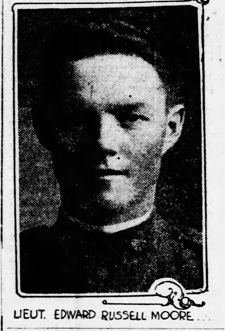(Laddonia, Missouri, February 8, 1895 – Tracy, California, May 28, 1969).1
Both of Moore’s grandfathers were farmers; one came from Kentucky and the other from New York to settle in the Midwest. Moore, the oldest of the three children of Edward D. Moore and Almina Moore, née Roberts, grew up around and helped with the horses that his father raised and sold.2 He also developed an interest in technology; a newspaper article from 1911 reports him joining a club of “wireless telegraph experimenters” and preparing to install a “wireless outfit at his home a mile and a half east of this city [Mexico, Missouri].”3 In the autumn of 1914, having graduated from Mexico’s McMillan High School, Moore began studying at the University of Missouri in Columbia.4 By 1916 he had joined the Missouri National Guard, and that summer he went to Laredo, Texas, as a member of a machine gun company taking part in the Mexican Punitive Expedition.5 Given his background it is not surprising that Moore’s actual work on the border involved horses. In a letter (signed “Russell Moore”—he evidently went by his middle name) dated July 15, 1916, he reports to his parents that “I am fairly squared away on my new job now. I have charge of twelve head of horses and four mules. . . .”6 On returning to Missouri he apparently did not reenter college, but instead took a position as stable manager on a horse ranch in Wisconsin.7
Moore did not remain long at the Wisconsin ranch; the summer of 1917 finds him briefly at Fort Sheridan, Illinois, and then at the School of Military Aeronautics at the University of Illinois at Urbana-Champaign.8 He graduated from ground school there on September 1, 1917.9 Along with most of the men from this class of about thirty, Moore chose or was chosen to go to Italy for flying training. He thus sailed with the 150 men of the “Italian” or “second Oxford detachment” to Europe, departing New York on September 18, 1917, on the Carmania. There was a brief stopover at Halifax, and then the Carmania set out across the Atlantic as part of a convoy. The 150 detachment members travelled first class. They enjoyed considerable leisure time but also attended Italian lessons, conducted by Fiorello La Guardia, who sailed with them, and, once the convoy entered dangerous waters, the men took turns on submarine watch. Moore, in a letter written home on November 7, 1917, recalled that “We were on the water two weeks almost to the hour. A vessel was sunk about one hour ahead of us one day, but our armada of ships came through all O.K. Much to my pleasure I was not affected with sea-sickness, some of the bunch were very sick. The weather was fine except one night, so all in all, we were very fortunate.”10 When the Carmania docked at Liverpool on October 2, 1917, the detachment members learned that they were not to go to Italy, but to stay in England and repeat ground school at the Royal Flying Corps’s No. 2 School of Military Aeronautics.
The men travelled by train from Liverpool to Oxford University and, for the first night, were assigned to various of the colleges. The next day they were divided into two groups: ninety men went to Christ College while the remaining sixty were housed at Queen’s. Jesse Frank Campbell, in the latter group, wrote in his diary that day that “Ed Moore, George Sherman, and myself have a large room on the fourth floor.” The three, from the same Illinois S.M.A. ground school class, apparently continued to room together when all the Americans were relocated to Exeter College in the latter part of November.11 The cadets (as they were now called) fairly quickly became reconciled to remaining in England, enjoying Oxford and the surrounding countryside in autumn, despite the frequent rain, and they had an easy time of it in their classes, which covered much of the same material they had had in the U.S. Moore, evidently aware of the events unfolding on the Italian front at Caporetto, remarked in his letter of November 7, 1917, that “In view of the present situation, I presume we were lucky in not being sent to our original destination.”12
In early November 1917 nearly all of the men of the second Oxford detachment were transferred from Oxford to Harrowby Camp, a machine gun school near Grantham in Lincolnshire, there being as yet insufficient openings at R.F.C. squadrons for them. Of the new accommodations Moore wrote that “The quarters are cozy but we are only allowed to keep a fire in the evening from three on. We have a lounging room furnished with papers, comfortable chairs and piano. The canteen and dining hall are in the same building. The mess is very good, considering the fact that these people have been at war for so long. The British officers are doing everything possible to make us comfortable. The captain who is mess president has already made arrangements for turkey, cranberries and ice cream for Thanksgiving.”13 There were golf and football matches; Moore made a trip to see nearby Belvoir Castle, and he and Sherman enjoyed an outing to Nottingham, the nearest large city to Grantham.14
In mid-November fifty of the men at Grantham were posted to R.F.C. training squadrons, including Jesse Campbell, who wrote that “I hate to leave Sherman and Ed Moore but I suppose it must come sooner or later anyways.”15 Moore and Sherman were at Grantham through Thanksgiving, and then, finally, on December 3, 1917, they and all the remaining members of the second Oxford detachment were posted to squadrons.
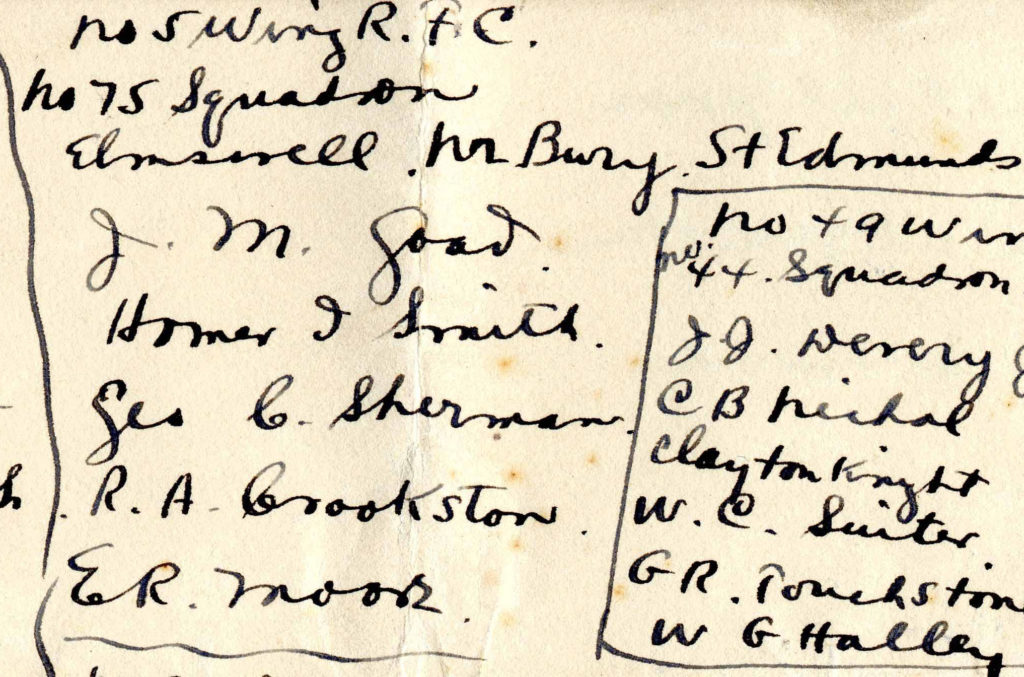
Moore was one of five sent to No. 75 Home Defense Squadron, located near Elmswell in East Anglia; the others, all from the same Illinois S.M.A. ground school class, were Ralf Andrews Crookston, John Marion Goad, Sherman, and Homer Ireland Smith.16 The men were actually billeted in nearby Stowmarket, at the Fox Hotel. Sherman wrote home that “A car calls for us every morning at 8:30 and brings us back every evening. The people at the hotel are mighty nice and do everything they can to make us comfortable.”17
While some of the cadets who had been assigned to home defense squadrons complained of little or no training and flying, the experience of the men at Elmswell, on the evidence of Moore’s and Sherman’s letters, was the opposite. Writing apparently in January 1918, Moore reports that “I am flying every day the weather permits; I am still doing dual control—that is, an instructor always goes with me. I have all the confidence in the world in him and I found my long course in ground school very essential because I know what to expect. When the old bus gets to cutting up with us I pull it back into true line, just as I would a horse after it had shied from a car or something. I was surprised that I kept my wits on the first trip. I did not have the least sensation of fear. . . . My ‘bunkie’ will soon be doing solos. I went splitting around and pulled several supreme mistakes, but I am still whole. I will try to avoid these mistakes in future. They are dangerous. I would rather fly than eat, and you know how well I like good thing[s] to eat.”18
The planes used operationally at this time at No. 75 Squadron were apparently the B.E.12, a single-seater plane, the B.E.12b (the same plane with a more powerful engine), and the B.E.2e, a two-seater.19 In the letter cited above, Moore goes on to write that “We are flying ‘Querks’ [sic] and ‘Soup kitchens.’ Fortunately George and I are on the former which receives its name on the strength of its resemblance to the Australian bird, the quirk, which can only fly a short distance. They land at 60 miles an hour and are fairly stable, moderately light on the controls. . . . George and I would live in the air if we could get a machine whenever we wanted it.” Moore’s “Querks” were presumably 75 Squadron’s B.E.2e’s, which could be fitted with dual controls.20
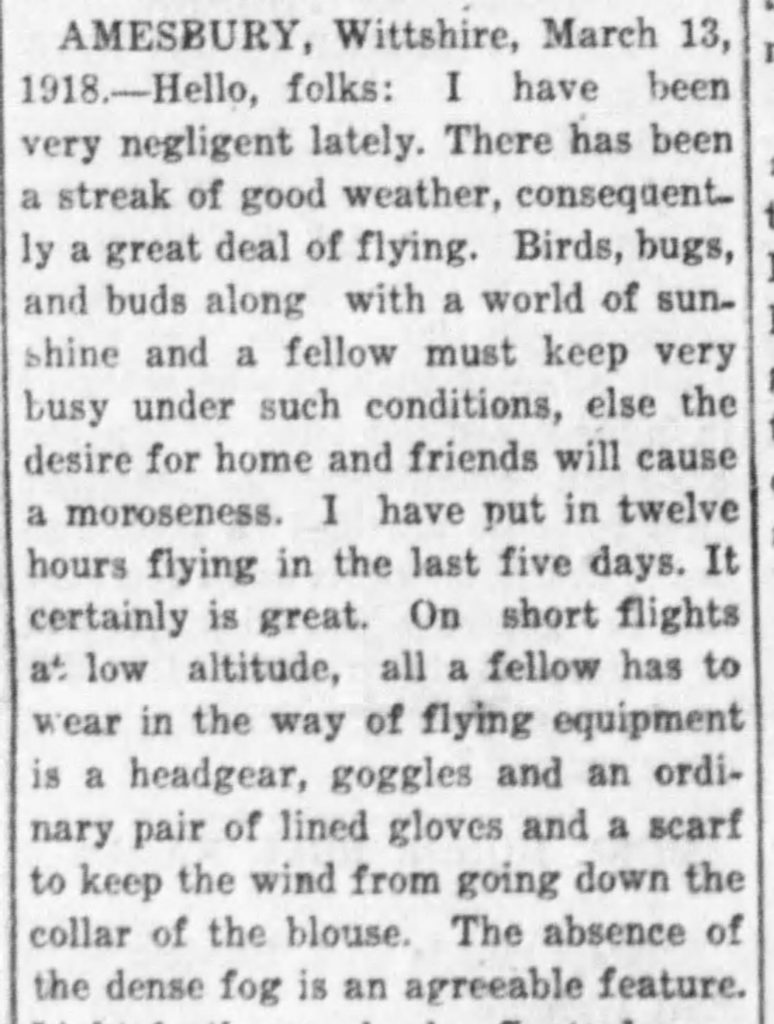
In a letter home dated January 27, 1918, Moore writes that “I have just been transferred to this place but will continue on the same type of machine I used at the other place, except to do some formation flying and bombing in some clumsy old box kites the name of which I may as well omit.”21 He had presumably just been transferred to No. 6 Training Depot Station at Boscombe Down just outside Amesbury in Wiltshire; a subsequent letter dated March 13, 1918, and presumably written from the same place gives his location as Amesbury.22 Planes at No. 6 T.D.S., one of the main training stations for day bomber pilots, included B.E.2e’s as well as DH.6s—the latter perhaps qualified as “old box kites.”23
At Boscombe Down Moore continued to pile on the hours. In his letter of March 13, 1918, he notes having put in “twelve hours flying in the last five days. . . . I have only put two machines in the hospital so far, and neither of the crashes were serious ones. I had a forced landing yesterday, when the engine failed. I did not get into a fine meadow that I had picked out to land in, but pushed the old tub into a ploughed field without any damage to the machine. The Major gave me a thirty-minute lecture over the phone—fortunately he could not see me smiling at his fury. He is a fiery Welshman.”  The Major was Bernard Francis Vernon Harcourt (whose mother was Welsh). Despite the lecture, Harcourt was evidently held in high esteem. Moore goes on to say that “There are seventy under instruction and the Major takes a personal interest in every man and officer under him. . . . Any man here would go through fire and brimstone for Major Harcourt.”
The Major was Bernard Francis Vernon Harcourt (whose mother was Welsh). Despite the lecture, Harcourt was evidently held in high esteem. Moore goes on to say that “There are seventy under instruction and the Major takes a personal interest in every man and officer under him. . . . Any man here would go through fire and brimstone for Major Harcourt.”
Two and a half weeks later, Moore wrote home that “I went solo on a service machine on Sis’ birthday,” i.e., on March 22, 1918; the plane was perhaps a DH.4.24 The next day the recommendation that he be commissioned a first lieutenant was forwarded by Pershing to Washington; the confirming cable came back dated April 5, 1918.25 Meanwhile, he and Sherman were “under canvas again. The permanent quarters are not completed. Sherman and I have a small tent together. We bought an oil stove and a few additional cooking utensils, so it is not as bad after all.”26
On April 7, 1918, Moore wrote home that “I put in nineteen hours and forty-five minutes in the air this last two weeks. Practically all of this time was in service machines. Four of my bunch, including myself, planned a 350-mile across country last Tuesday. [Phillips Merrill] Payson and I made the course, Sherman got lost in the clouds about half an hour from home on the start and [Robert Jenkins] Griffith got lost over Ipswich. The most distant point was Elmswell. It took us five hours and a half. Payson and I returned through a wind and rain storm. . . . I was sure glad to see the home field about 7:30 in the evening after three hours’ continuous flight.”27 On April 10, 1918, Moore received his “certificate of graduation” and prepared to take his four days graduation leave in northern England.28 He was placed on active duty on April 17, 1918.29
There was more training to be done, and there were still some bottlenecks, which meant that Moore continued at Boscombe Down until nearly the end of May 1918. While there, on or about May 21, 1918, he experienced what he regarded as his first serious crash.
I had finished my course . . . and was hanging around waiting to be posted here [Turnberry]. One of the fellows asked me to fly down to Bournemouth and bring a friend back. . . . I had engine trouble before I started. The mechanic finally fixed me up. . . . I reached Bournemouth all right, picked up my passenger and started for home. . . . The engine cut out. I picked out a lovely field but failed to turn into the wind until we were about seventy-five feet from the ground. I did not have time to pull the bus up before the wheels struck the ground. . . . The passenger came out with a disfigured face and I nearly broke a leg and got an ugly cut across my kneecap. The machine was worthless. It was my first crash after practically a hundred hours of flying. It was the last time I flew at [Boscombe Down]. I hated to dirty my clean slate, but no one was hurt seriously, so I am still happy.30
The farmer in whose field Moore had crashed invited him home, where his wound was attended to, and friendly relations were firmly established when it turned out that the farmer’s brother was employed at a college in Fayette, Missouri, not far from Columbia.31
After a few days in Bournemouth nursing his stiff leg, Moore left for the No. 1 School of Aerial Fighting & Gunnery (which became the No. 1 Fighting School on May 29, 1918) located at Turnberry and Ayr on the west coast of Scotland.32 From Turnberry he wrote that “This has been a delightful change, both from the standpoint of military training and personal enjoyment. From tents to what in peace times is a flourishing pleasure resort, an immense hotel which faces the sea, situated on a fairly high hill, terraces dotted with flower beds and shrubbery, tennis-courts, croquet grounds, on down to a very famous golf course. . . .”33 By June 2, 1918, he had “practically finished a week’s course on advanced ground gunnery, six hours a day on the range and two hours for lectures. Following this comes a course in aerial fighting and aerobatics under the most expert instructors. . . .”34 Within a day or so of Moore’s arrival at Turnberry, an Illinois S.M.A. ground school graduate, Howard Rea Smith, died when his Camel spun into the ground. “We paid our last respects to one of our fellows last Thursday [May 30, 1918]. I had to act as pallbearer. . . . An unlucky crash, of course—a very depressing incident which is among all too many now.”35
In an undated letter, probably from mid-June 1918, Moore alludes to his movements after completing his course at Ayr: “I have been ordered overseas once but called back at the last minute. The work is very interesting. I go from here [Ayr?] to a place about ten miles from where I was before to do some special work on new experiments. I am sorry I can not write details. . . .”36 Moore’s anticipated final station after Ayr was probably the Wireless Telephony School at Chattis Hill, about ten miles east of Boscombe Down. C. G. Jeffords, in Observers and Navigators, describes how “Experimental work on speech transmission was under way in the UK by May 1915”; field trials in wireless telephony were undertaken in France in 1917. The Wireless Experimental Establishment at Biggin Hill started training Bristol Fighter and DH.4 and DH.9 crews in January 1918; in early April 1918 the training was “taken over by the newly established Wireless Telephony School which moved to Chattis Hill” around April 15, 1918.37 Such technology must have seemed a huge advance over the Morse code transmission and reception the second Oxford detachment members had spent so many hours learning and practicing.
Apparently just as he was about to be posted to France, Moore fell ill. On July 12, 1918, he reported that “I am a happy boy now. I finally broke out of hospital in London. I was confined for a week with this Spanish influenza. . . .The Fourth of July I was flat on my back in the hospital, with a burning desire to be allowed to sleep for a hundred years.” By the time he wrote this he had made it to Paris, but was “still weak, as anyone would be from a fever.”38 He expected to be posted to a squadron forthwith, but apparently, once fit to fly again, served instead for a time as a ferry pilot.39
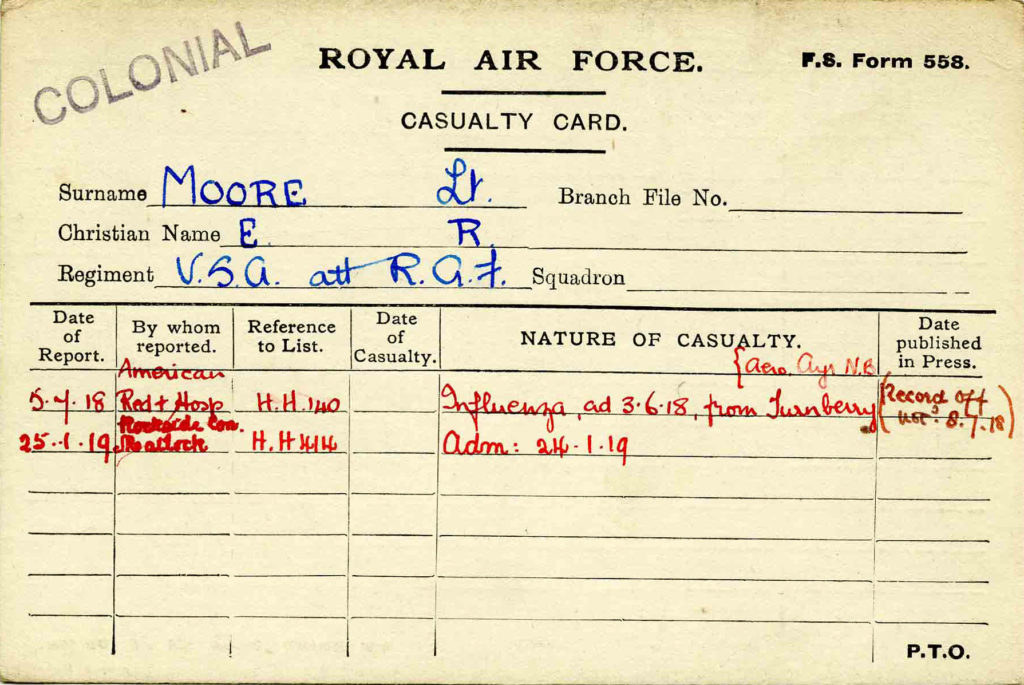
Finally, on August 18, 1918, Moore along with fellow second Oxford detachment members Anker Christian Jensen, Edward Addison Griffiths, and John Howard Raftery, reported to the U.S. 8th Aero Squadron at Amanty in Lorraine; they were soon joined by Hilary Baker Rex and Newton Philo Bevin.40 The 8th Aero was an observation squadron flying DH-4s, the American version of the British DH.4. The 8th had been at Amanty since the last day of July, attached to the I Corps Air Service of the American First (and at that time only) Army.
In mid-August 1918 the squadron was doing intensive training, including making flights over the lines. On August 31, 1918, as part of the planning for the St. Mihiel Offensive, they were transferred to IV Corps and moved north to Ourches-sur-Meuse, where the IV Corps Air Service was based. Moore was assigned to A flight, and a roster dated September 10, 1918, indicates that he was flight leader, with William Byington Wynn as his observer.41 The squadron flew reconnaissance missions in preparation for and during the Battle of St. Mihiel in support of the 1st Infantry Division at the western end of the American front. On the 12th and 13th planes of the 8th Aero “were in the air for thirty-six hours and thirty minutes . . . and twenty-four separate missions were accomplished.”42 Wynn received a Silver Star Citation, having “distinguished himself by gallantry in action while serving with 8th Aero Squadron, American Expeditionary Forces, in action in the St. Mihiel Salient, France, 12 September 1918, while on an infantry liaison mission.”43 It seems likely that Moore was Wynn’s pilot on the 12th, but the only account of a mission that day I have been able to find, Moore’s own in a letter home, is only an excerpt; it does not name his observer and does not provide enough detail to indicate what role Wynn might have played: “I piloted the first infantry contact patrol machine on the line on the morning of the twelfth. . . . The roar of my engine drowned out all other sounds except when a large shell burst near. Signal rockets of every color pushed up at different points. The artillery flashes from both sides, the thin streaks from the rifles and every shell burst gave up an angry red spurt. Tanks were creeping along with the advancing infantry. The Huns were going east in long streams.” The newspaper article that cites Moore’s letter then paraphrases: “[Moore] goes on to tell of bombing a machine gun which the Huns were holding on the American lines, and of ‘swishing’ over a German Village and seeing the inhabitants run for cover.”44
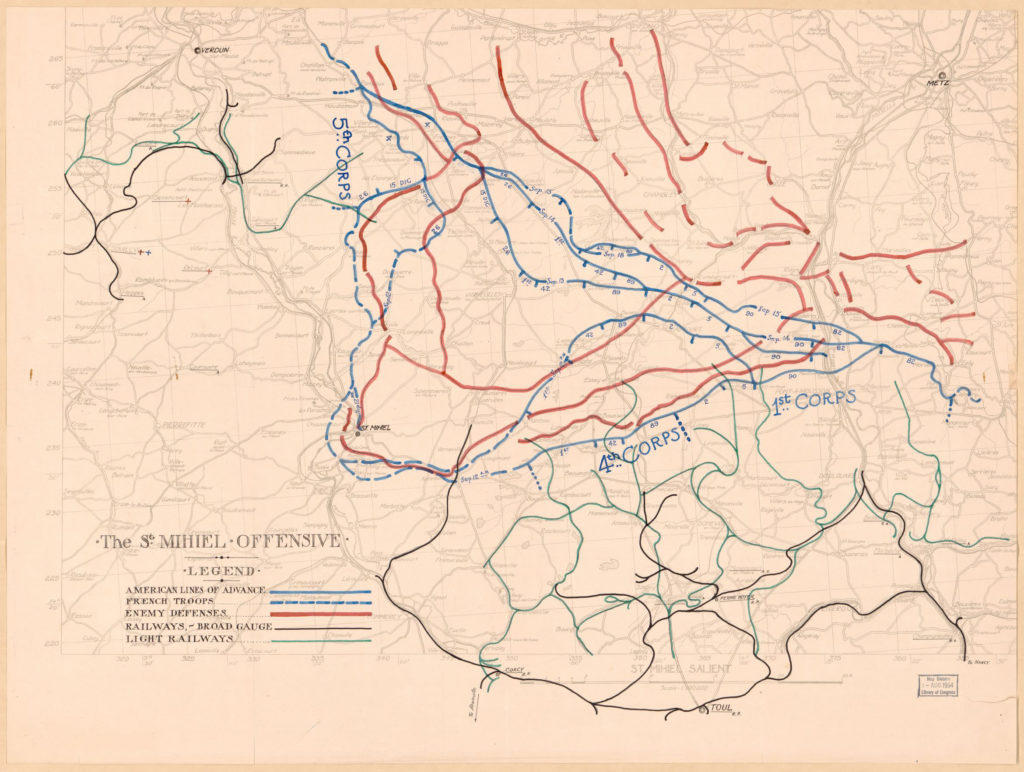
A photo mission was scheduled to take a strip of German territory important in the eyes of our army, but early morning clouds and drizzle seemed to prophecy a dead day. . . . Around lunch-time, encouraged by a bit of blue sky here and there Lieut. Moore the flight leader decided to chance it. . . and three machines taxied onto the field in position, Moore pilot and Allen observer in the leading machine containing the camera, [Albert Elliott] Parrish and [Edward Henry] Hobbs in the left-hand protection machine, and Raftery and [John Harold] Mulherin in the right-hand protection machine. After five minutes wait the fourth bus still persisted in spouting water from its leaky radiator so Moore, determined on braving the Huns with only three planes, waved his hand. Three throttles opened together, and three
D H 4’s bounded across the field and up into the air. . . . when at Pont-a-Mousson Moore sighted eight Fokkers coming in from Metz, he cocked his guns once more to make sure and continued North up the [Moselle] river. Our formation at the required 10,000 feet manoeuvered to directly over Arnauville [sic; sc. Arnaville], the starting-point, and the Huns manoeuvred toward our formation. As our formation turned N.E. they came over on top, turning behind to follow at about 500 yds. . . . the Hun leader dived. He came in pretty close behind the formation, pulled up and let loose with both guns. On Moore’s machine a landing wire snapped on one side of him, a flying wire waved in the breeze on the other side and his elevators received a shower of bullets. Disregarding these white streaks of tracers shooting by on all sides, Moore kept directly on his course and Allen in the observers cockpit without making a move toward his guns to defend himself continued snapping his pictures and changing plates. . . .
The protection planes did their job, and the Fokkers eventually departed. The next hazard was anti-aircraft fire, which “cut still another rip in the leader’s wings. . . . At Lake Lachausee the last picture was snapped and the leader Moore, banking to the left, started the formation for home. In his cockpit Allen carried the hard-earned pictures which turned out to be clear overlapping photos of the exact territory required.”49
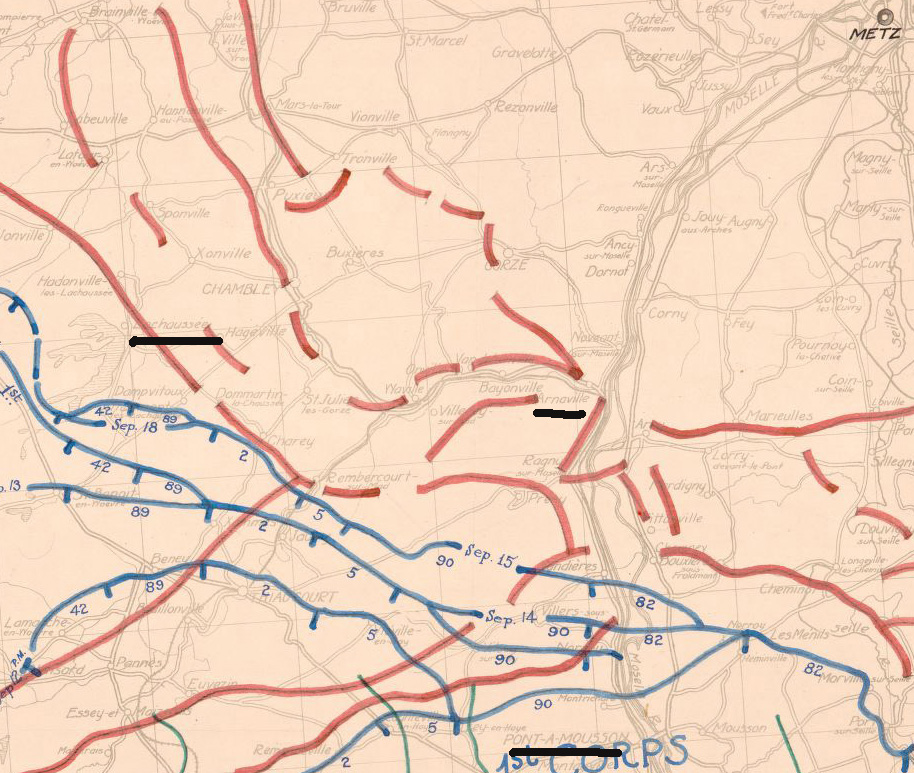
On October 23, 1918, the 8th Aero moved once again, this time about ten miles northeast to Saizerais where, again, they undertook voluntary bombing missions.50 The 8th was now part of the Air Service of the recently formed Second Army, whose “task was to begin a general offensive leading to the capture of Metz and the gateway into Germany proper.”51 The armistice supervened. Seven days later, on November 18, 1918, Moore and Allen were each awarded the Distinguished Service Cross for their work on October 9, 1918.52 Jesse Campbell, visiting this part of the front just before Thanksgiving, noted in his diary: “Saw Eddie Moore. He has the D.S.C.”53
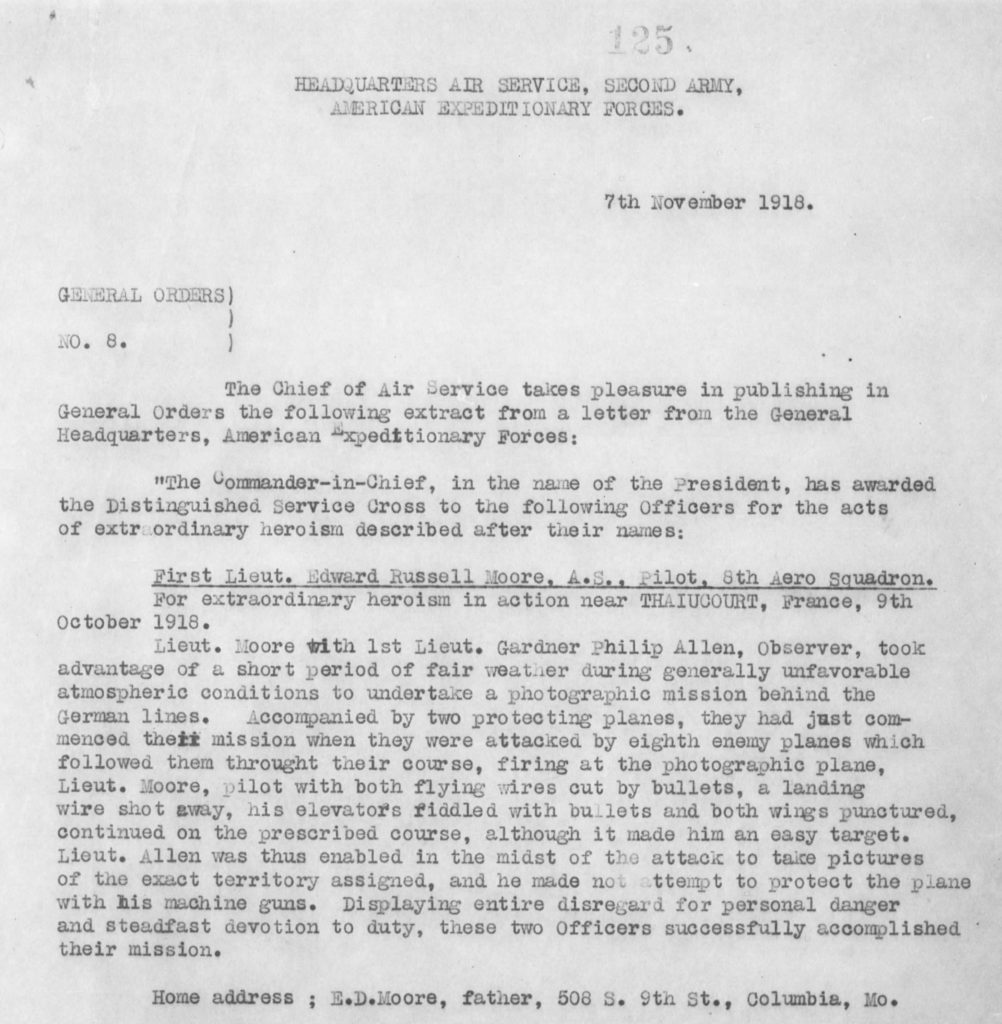
Moore was able to return to the U.S. in March 1919; he sailed from Marseilles on the Argentina on March 3, 1919; the ship docked in New York on March 26, 1919.54 In the 1920 census his occupation is given as “pilot,” and he continued to fly over the next two decades.55 His World War II draft registration shows him employed by the Polaris Flight Academy at War Eagle Field in the Mojave Desert.56
mrsmcq August 5, 2020
Notes
(For complete bibliographic entries, please consult the list of works and web pages cited.)
1 For Moore’s place and date of birth, see Ancestry.com, U.S., World War I Draft Registration Cards, 1917–1918, record for Edward R Moore. For his place and date of death, see Ancestry.com, California, Death Index, 1940-1997, record for Edward R Moore; and Sue, “Edward R Moore.” The photo is taken from page 1 of the St. Louis Post Dispatch of December 19, 1918.
2 On Moore’s family, see documents available at Ancestry.com.
3 L. M. W. “The Roundup.’
4 See“Letters from Soldiers” (May 23, 1918) on his high school; University of Missouri, Biennial Report, p. 293.
5 “Russell Moore Goes to War.”
6 “Horses Still His Job.”
7 See Moore’s draft registration, cited above, and “Russell Moore to New York.”
8 “Columbia Boy in Aviation Corps.”
9 “Ground School Graduations [for September 1, 1917].”
10 “Letters from Soldiers”( December 13, 1917).
11 Jesse Campbell, diary entries for October 3 and 22, 1918.
12 “Letters from Soldiers” (December 13, 1917).
13 Ibid. See Hooper, Somewhere in France, notes to letter of [November] 4, 1917, where I have identified Moore as one of Parr Hooper’s hut mates based on the caption to a photo taken by Hooper. I was unaware that there was also a Charles Francis Moore in the detachment; it is uncertain which Moore appears in the photo.
14 “Letters from Soldiers” (December 13, 1917).
15 Jesse Campbell, diary entry for November 15, 1917.
16 Foss, Papers, “Cadets of Italian Detachment Posted Dec 3rd.”
17 “George Sherman is Taking Rapid Steps in the Flying Game”; the Stowmarket hotel is identified in “Lieutenant Sherman is Anxious to Sail.”
18 “Letters from Soldiers” (March 14, 1918).
19 See Philpott, The Birth of the Royal Air Force, p. 416, on the planes available at No. 75 Squadron.
20 Lee, No Parachute, pp. 4–5, writes “Six of us were detailed to ferry B.E.2es to No 2 A.D. I hadn’t flown a Quirk for months, . . .” This is the only primary source reference to a B.E.2e as a “quirk” I have found; there are secondary sources that gloss “quirk” as any training plane (Holmann, “Cabbage crates coming over the briny?”), as a B.E.2 generally, or as a B.E.2c (Hart, Bloody April, Ch. 6). Moore’s “soup kitchens” remain unidentified.
21 “Letters from Soldiers” (March 14, 1918).
22 “Letters from Soldiers” (May 23, 1918).
23 On 6 T.D.S. and the planes available for instruction, see the November 25, 2006, contribution by mickdavis at “Introduction and new Question TDStations,” as well as Sturtivant, Hamlin, and Halley, Royal Air Force Flying Training and Support Units, p. 294.
24 “Letters from Soldiers” (May 23, 1918); for his sister’s birthday, see Ancestry.com, U.S., Social Security Death Index, 1935–Current, record for Agnes Bohman.
25 Cablegrams 770-S and 1046-R.
26 “Letters from Soldiers” (May 23, 1918).
27 Ibid.
28 Ibid.
29 McAndrew, “Special Orders No. 205.”
30 “From Trench and Camp” (July 15, 1918). I find no casualty card and no entry in Sturtivant and Page, The D.H.4 / D.H.9 File, for this incident.
31 Research at Ancestry.com and the web generally indicate that the brother was Alfred P. Warren, son of Rev. William Warren; the latter had emigrated from Wiltshire to Missouri in about 1850. I have not identified Moore’s farmer host with any certainty.
32 On the names given the training stations at Turnberry and Ayr, see Jeffords, Observers and Navigators, p. 51, and “No 1 Fighting School Turnberry”[GWF disc. thread]
33 “From Trench and Camp” (July 15, 1918).
34 Ibid.
35 Ibid.
36 “From Trench and Camp” (July 16, 1918).
37 Jeffords, Observers and Navigators, p. 369.
38 “Letters from Soldiers” (August 22, 1918). Moore’s casualty card (“Moore, E.R.”) appears to have misdated his admission to hospital as June 3 rather than July 3, 1918.
39 “Is Delivering Planes.”
40 “8th Aero Squadron,” pp. 140-41.
41 “8th Aero Squadron,” p. 134. See p. 142 for dates of Wynn’s assignment to the 8th Aero, Sept 1–23, 1918.
42 8th Aero Squadron,” p. 116; this is part of the “Report on Operations against the St. Mihiel Salient” submitted by squadron C.O. John Gilbert Winant, which is also reproduced on pp. 689-91 of Maurer, The U.S. Air Service in World War I, vol. 3. Unfortunately operations reports that might provide details of individual flights appear not to have been preserved; they are not, for example, in Gorrell C.14.
43 “William B. Wynn.”
44 “M. U. Student Bombs Germans from Air.”
45 Maurer, The U.S. Air Service in World War I, vol. 1, p. 245.
46 “8th Aero Squadron,” pp. 111 and 112.
47 Ibid., p. 111.
48 Ibid., pp. 119–20.
49 Ibid., p. 120.
50 “8th Aero Squadron,” p. 112.
51 Sloan, Wings of Honor, p. 360.
52 See “8th Aero Squadron,” pp. 125–26 and 145. Frank Purdy Lahm’s General Orders No. 8 with the text of the awards (pp. 125–26) is dated November 7, 1918; the 8th Aero Squadron roster, p. 145, gives November 18, 1918, as the award date, perhaps referring to the award ceremony.
53 Jesse Campbell, diary, November 22, 1918.
54 Ancestry.com, U.S., Army Transport Service, Passenger Lists, 1910-1939, record for Edward R Moore.
55 Ancestry.com, 1920 United States Federal Census, record for E Russell Moore; 1940 United States Federal Census, record for Edward R Moore.
56 Ancestry.com, U.S., World War II Draft Registration Cards, 1942, record for Edward Russell Moore.

